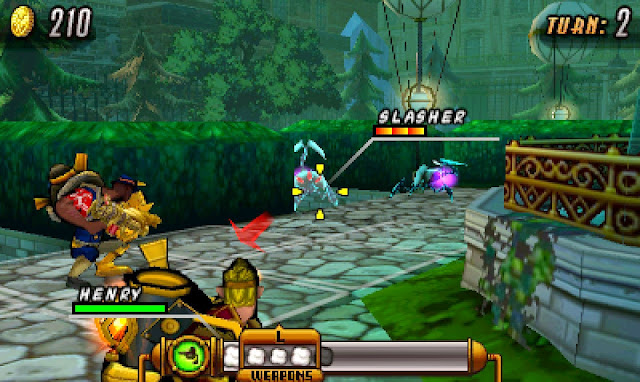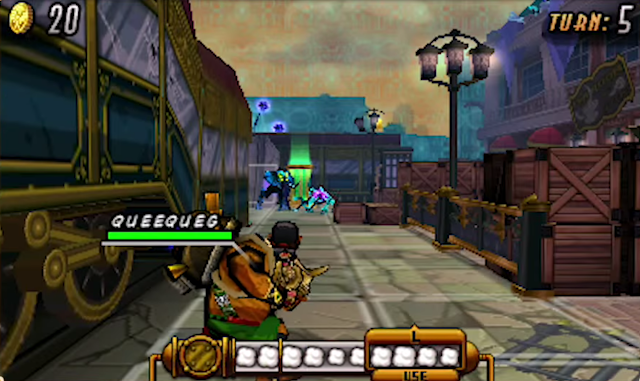Playing Code Name: S.T.E.A.M actually felt like a betrayal. Until this game Intelligent Systems had never done me wrong. From Fire Emblem to Pushmo, Advanced Wars to Paper Mario, Intelligent Systems has one of the most stellar track records of all developers, and its upcoming Fire Emblem and Shin Megami Tensei crossover is one of my most anticipated games across all platforms, let alone the Wii U.
But Code Name: S.T.E.A.M is a shallow, poor man’s XCOM, with a garish personality and quite broken sense of aesthetics. I was cautiously optimistic at its reveal as a surprise new IP last year, but that was only because I had faith in Intelligent Systems. It wasn’t the early footage that piqued my interest. Then I wasn’t a fan of the demo, and now, with the full game, an instant dislike of it took hold and never let up.
The theme behind the game is genuinely irritating. In a steampunk alternative universe Abraham Lincoln somehow avoids being assassinated (and fakes his own death to disappear from public life) and sets up a small team of crackpot heroes to fight off an alien invasion. Heroes who are themselves taken from an odd mix of classic literary characters. Every word above reveals some kind of fundamental issue with the game that is immediately obvious within the first couple of minutes of play and doesn’t improve as the game rolls on.
Nothing is done with the steampunk setting, for a start. The general visual style of steampunk art is certainly blatant, and the power of “steam” is what fuels each hero’s ability to move around and fire their weapons. So far, so okay, but in better examples of the genre, steampunk is more than just a visual style, and Code Name: S.T.E.A.M never seems to understand this. Steampunk is a genre that so effectively delves into the relationship between humans and machines, both exposing and questioning our reliance on them, and whether we can replace human functions with mechanical constructions without dehumanising ourselves in the process. It’s a primitive or ‘wild west’ complement to the cyberpunk genre, in other words, and many of the themes are transferable between the two. It’s not always a pleasant theme, sure, with the steampunk genre often leaving the viewer uneasy about his or her relationship with metal things, but that’s the point. It’s not meant to be a bright and happy world of comic book-like heroes that look and behave like they were designed for ten year olds.
And so, while each of the heroes in Code Name: S.T.E.A.M. do indeed use weapons powered by this resource called “steam”, and these weapons give them abilities beyond what a normal biological being should be capable of, there is so little done to delve deeper into the kinds of themes or meanings that the steampunk setting should enable. This game is no Bioshock Infinite or even Final Fantasy VI, games that do a far more effective job in holding true to the steampunk genre’s values. It’s a game that simply uses the genre’s penchant for bright, bold colours and assumes people will love it simply because it exists.
It’s a thematic misfire, and those colours are ever comfortable on the eyes anyway. I appreciate the comic book aesthetic that the developers were aiming for, but environments and character designs are so relentlessly colourful that the experience becomes draining from garish overload over the long term. Coupled with the persistent behind-the back close camera angle, and the need to constantly pan around to spot enemies and try and track down hidden secrets, Code Name: S.T.E.A.M’s visual design ends up building an endless blur of pure ugliness. Characters and environments don’t lack for detail, but they are completely unpleasant to look at, and as a fan of better examples of steampunk design, this is nothing short of crushing.
The characters end up being a misfire, too. Abraham Lincoln is about as appropriate to this game as the character was in Abraham Lincoln: Vampire Hunter. I certainly know the man’s history and understand why he is one of the most revered figures in American history, but I feel no patriotism for the character and have very little interest in seeing him elevated to a Nick Fury-like role of omnipotent genius and the puppet master behind all heroics through the narrative. The characterisation of the other heroes, meanwhile – all of which I recognise from the books I have read – is so threadbare I actually forgot what inspired them. Moreover, given that one of Lincoln’s first acts is to order the all-American team of commandos to break into a palace and rescue the queen of England, and my mouth was immediately filled with a taste of both the irritating damsel in distress trope and cliche as well as blatant American imperialism, and the narrative never did enough after that to wash that aftertaste out for me. It’s remarkably insensitive scenario design and writing, and coming from a Japanese company it’s mind-boggling in how purely odd it all is. With a more appropriate art design, Code Name: S.T.E.A.M could have been a surrealist masterpiece in how completely weird everything about it is, but steampunk doesn’t do surrealism well, and the nothing about the characterisation or narrative matches with the art style, creating a greatly inconsistent experience from start to finish.
The turn-based tactical gameplay is executed competently, but let down by a number of silly oversights that weigh down the experience. Maps are overly long and character movement across them is slow and cumbersome. Enemies generally have to be dealt with using a full squad of characters concentrated closely together, because their numbers tend to be large. This means that you’ll settle into a pattern where you’ll progress to a point of a map with a group of characters, work them together to clear it of enemies, and then send them around to explore for secrets and loot, before joining them back together to go after the next set of enemies further down the map.
It’s a ponderous loop, and the slow pace of character movement leaves the impression that it’s even laboured that it should be. Code Name: S.T.E.A.M knows how to be challenging, and is happy to hit players who make mistakes quite hard, and so you’ll also need to take the time to carefully survey the terrain and then figure out how to take advantage of it all. This is made more difficult than it should be because of the behind-the-back camera that makes it hard to get a sense for the overall battlefield, and constantly swinging the camera around to try and get a look at what’s going on around the characters is a frustrating and laboured mechanical design (and, as I mentioned before, painful on the eyes).
It’s also less strategic than tactical games that it borrows so heavily from, such as XCOM. With no proper cover mechanic there’s less need to capitalise on the terrain (other than to be able to move behind something that blocks line of sign from the occasional really dangerous ranged enemy), and while Intelligent Systems displays its usual excellence in level design, the combat simply isn’t technical enough to make moving through these maps as entertaining as they should be. There are save points scattered across each map; an apparent concession to them being too large to rely on players completing them in one go, but even so, the start of each mission can be intimidating, not because of an impending challenge as much as a raw fear from a thought along the lines of “my goodness, how long is this going to take?”
Each character doesn’t offer much personality through the narrative, though they do at least play differently to one another. Each has special weapons and powerful one-off attacks that are different enough from one another to affect your approach to any given level. Capped at four heroes per level you’ll need to be careful about which ones you take into battle, but the strategy in using these characters is quite limited in execution. If Intelligent Systems had have worked through skills or abilities that required characters to work together it would have helped, but as Code Name: S.T.E.A.M sits at the moment, it’s a small team of individuals fighting like individuals, and that structure has limited tactical or strategic value.
None of these issues mean that the game is broken, unplayable, or even put together badly. It’s competent. But competent really isn’t good enough. More than anything else, Code Name: S.T.E.A.M is disappointing because it could have been a far better game. With a developer with such experience in tactical games as Intelligent Systems has, there is no excuse for a game that is this limited, this garish, and this incohesive. If this is to be built into a franchise, it’s going to need a dramatic improvement by the next game.
– Matt S.
Editor-in-Chief
Find me on Twitter: @digitallydownld










